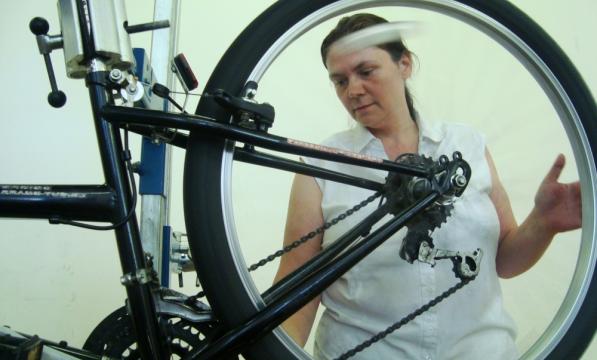Donna - from learning to cycle to learning cycle maintenance

Why did Donna take up adult cycle training?
Donna came to adult cycling sessions to work toward being a first-responder-on-a-bike in St John’s Ambulance. She is already an advanced first-aider, but needed to learn to ride on the road. She saw others in the park wearing bright yellow vests, and then an instructor came to the 'Fit and Active' group Donna attended, offering free cycling courses to people who were trying to get fitter.
Donna said that she wasn’t too nervous at the start – she just didn’t want to fall. Although wobbly to begin with, she took the view that ‘everybody is, aren’t they?' Being with other people doing difficult things made a course better than one-to-one tuition for Donna.
What next?
Donna feels that she has recaptured a sense of excitement. The last time she was on a bike (an orange chopper with a gear shift and a long seat) she was eight - when she took it up again, she was 41. Donna has now named her new used bike, wants to get stronger riding for St John’s and also, ultimately, she wants to cycle a wheel-chair bike so she can take her 10-year-old son out with her.
Donna has taken on more and more cycling challenges. She attended a two-week, Level 2 maintenance course because she’s ‘always wanted to be able to fix my bike’. Donna knew it was a complete maintenance course, but thought it might start with punctures, something she had at least seen in her cycle training course, but no: "We started with changing wheel bearings in the hub and brake cables!"
Donna is also interested in learning to lead and will take instructor courses. She is a valued graduate of the cycle training course she took, volunteering her time to support learners even newer than herself. Her recent knowledge and experience helps her empathise and support people who are wobbly and nervous. She promises, and can prove, that the wobbles pass. Donna is able to remind them of what they learned the week before.
Donna also notices that she is gradually getting fitter. She says, "I’ve got abs now, I can feel them. Cycling has made me healthier. When I can take my son with me, I’ll be out more." Donna has seen photos of the sort of bike she needs for her son, and was moved that people taking the maintenance course with her have talked about trying to build one for her.
Observations about learning to cycle
Thinking about what it was like to learn to ride, and to move onto riding on roads, Donna mentioned her trainers. She noticed the need for reassurance rather than permission, and that an instructor was "like a safety net". She commented on type of learning that her instructors aimed for, saying: "She asked me what I wouldn’t do, I named a really scary roundabout, and that’s where we went."
Donna said she was very pleased, after the fact, and felt happier driving around the same roundabout now that she has studied it as a cyclist. She also spots more bikes on the road now when she drives, and "I notice them in the wrong position."
The sociability of the course was very important for Donna and others. Over the course of twelve weeks, a feeling grew within the group. They would bring samosas, food they had made and they laughed together. The instructors were happy with whatever learners decided to do with their new skills, though they encouraged going out and getting a bike. One instructor said, "I don’t want them to learn and never ride again." Because some people can’t store bikes in their home, the project is starting rides where people can borrow bikes, as they did when they were taking the course.

